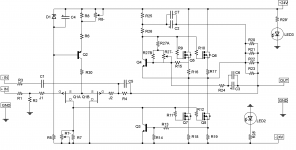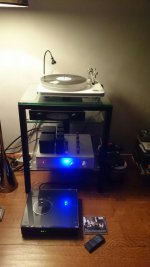I have rewired everything, putting as much distance as possible between ac/dc cables, twisting, signal away from all other, shortened wires, checked rca connectors etc.
The hum persists.
Running a wire directly between the two cahnnels gnd made no difference.
I shorted rca inputs, and both channels gets quiet.
Stefan
The hum persists.
Running a wire directly between the two cahnnels gnd made no difference.
I shorted rca inputs, and both channels gets quiet.
Stefan
Hi,
Being a novice at building amps, I gave it a try and have build the Aleph J. It works!
With Avantgarde Uno horn speakers, I have extremely efficient speakers and with that encountered hum problems.
Not saying the hum-issue has been completely solved yet, I got some major improvements after re-adjusting the offset and after re-arranging the input wires so that they run as far from the transformer as possible.
In my system, the hum almost completely disappears when I short the input. With open input the hum slightly increases and with interconnects (7 meters) connected it increases (much) more.
Being a novice at building amps, I gave it a try and have build the Aleph J. It works!
With Avantgarde Uno horn speakers, I have extremely efficient speakers and with that encountered hum problems.
Not saying the hum-issue has been completely solved yet, I got some major improvements after re-adjusting the offset and after re-arranging the input wires so that they run as far from the transformer as possible.
In my system, the hum almost completely disappears when I short the input. With open input the hum slightly increases and with interconnects (7 meters) connected it increases (much) more.
7 meters ?
for that - 600ohms driver stage preceding cables , decrease J input impedance to 600R and zilch hum
for that - 600ohms driver stage preceding cables , decrease J input impedance to 600R and zilch hum
Hi Zen Mod, I use 7 meters because I build the J's as mono's and they're sitting right next to the speakers...
Would this mean changing R1 from 22K1 to 640R? R2 would in that case stay 221K.
As said, I am a novice, so please do not laugh at my question: by using another combination for R1 and R2 (say: 1K2 for both), would the gain change? I ask this because I have too much gain in the chain right now. Considering this, I maybe better have built a F4...
Would this mean changing R1 from 22K1 to 640R? R2 would in that case stay 221K.
As said, I am a novice, so please do not laugh at my question: by using another combination for R1 and R2 (say: 1K2 for both), would the gain change? I ask this because I have too much gain in the chain right now. Considering this, I maybe better have built a F4...
Yes, I use RCA's to connect preamp to J's.
The preamp is a tube-amp. Active parts are two 6N6P-tubes per channel. The output impedance should be around 400 Ohms (the second 6N6P is wired in parallel). The preamp is a self-build from Triode Dick and is named Classic One. If you Google this you will get to his site. In The Netherlands he's quite well-known.. he has a world-reputation in Holland 🙂.
The preamp is a tube-amp. Active parts are two 6N6P-tubes per channel. The output impedance should be around 400 Ohms (the second 6N6P is wired in parallel). The preamp is a self-build from Triode Dick and is named Classic One. If you Google this you will get to his site. In The Netherlands he's quite well-known.. he has a world-reputation in Holland 🙂.
Not hum this time..
I got a IR pen/meter for temperatur measurement, which gave me concerning results.
Right channel Q5 measured: 85 C
Right channel Q8 measured: 77 C
All other mosfets 63-69 C
Heatsinks 42-44 C
Measured after amp had been sitting for 30 minutes with no load.
Bias right channel R18- 400mv, R19- 417mv
Left channel R18 and R19- 400mv
DC offset both channels- 0
What might cause such temperator spikes on the two transistors?
Is it common practic to use thermal paste together with Keratherm? I did not.
Stefan
I got a IR pen/meter for temperatur measurement, which gave me concerning results.
Right channel Q5 measured: 85 C
Right channel Q8 measured: 77 C
All other mosfets 63-69 C
Heatsinks 42-44 C
Measured after amp had been sitting for 30 minutes with no load.
Bias right channel R18- 400mv, R19- 417mv
Left channel R18 and R19- 400mv
DC offset both channels- 0
What might cause such temperator spikes on the two transistors?
Is it common practic to use thermal paste together with Keratherm? I did not.
Stefan
Not hum this time..
,,,,,,,,,,
What might cause such temperator spikes on the two transistors?
Is it common practic to use thermal paste together with Keratherm? I did not.
Stefan
torque ?
Hi,
Being a novice at building amps, I gave it a try and have build the Aleph J. It works!
With Avantgarde Uno horn speakers, I have extremely efficient speakers and with that encountered hum problems.
Not saying the hum-issue has been completely solved yet, I got some major improvements after re-adjusting the offset and after re-arranging the input wires so that they run as far from the transformer as possible.
In my system, the hum almost completely disappears when I short the input. With open input the hum slightly increases and with interconnects (7 meters) connected it increases (much) more.
Hi VDO,
A reminder that ground loop voltage develops over a distance of wire by it's resistance R and the small current flowing through it. The longer the cable, the higher the voltage, and hum will become more audible.
Another thing I discovered was a pretty simple trick. If you are using a toroid, and your wire lengths allow it, you might try loosening and rotating it, about about 45 degrees at a time, then listen or scope the output for noise. I found this cancelled the remaining hum on my FET amplifiers (although I didn't end up building the Alpha J)
Also, as others have pointed out, a solid ground bus - as in a single point ground - is essential.
Good luck, I know it's annoying and can be frustrating.
@ZenMod: I wil do this tomorrow and report back. Thanks a lot so far.
@Roger: with the input so far, the hum is getting manageable. Unfortunately the wires on the toroid are not that long. I will check for the ground bus and will relocate the CL60 close to the earth wire at the mains entree (it is at the 0 point at the PSU now, this acts as the central ground). Thanks for the advice.
Vranc
@Roger: with the input so far, the hum is getting manageable. Unfortunately the wires on the toroid are not that long. I will check for the ground bus and will relocate the CL60 close to the earth wire at the mains entree (it is at the 0 point at the PSU now, this acts as the central ground). Thanks for the advice.
Vranc
Yes, I use RCA's to connect preamp to J's.
The preamp is a tube-amp. Active parts are two 6N6P-tubes per channel. The output impedance should be around 400 Ohms (the second 6N6P is wired in parallel). The preamp is a self-build from Triode Dick and is named Classic One. If you Google this you will get to his site. In The Netherlands he's quite well-known.. he has a world-reputation in Holland 🙂.
VDO
How large are the output capacitors on your preamp. I ask this because it is fashionable these days to sometimes use really small capacitors. A small capacitor will have a large impedance at 60 hz or even at 120hz where full wave rectified noise happens. For instance, a .5uf capacitor will have an Xc of over 5kohms at 60hz. This will make hum pickup much more likely in the 7metre interconnects.
Thanks Bfpca. In fact, the C is .33 uF, so this is something to consider as well. As I am Dutch, I tried to keep them small-and-cheap... why is teflon so expensive?
@Nafets77: I used stainless steel clips for mounting the Mosfets. It's very convenient, you cannot over-tighten things and the pressure on the Mosfets is quite even.
@Nafets77: I used stainless steel clips for mounting the Mosfets. It's very convenient, you cannot over-tighten things and the pressure on the Mosfets is quite even.
@ VDO
decrease R2 to 4K7 and inform
you can solder 4K7 to 5K1 across original one
Hi Zen Mod,
Followed your advice... and it works like a charm!
Although the main hum inducer turned out to be a dimmer), the hum is even les now. In fact it's very quite in de listening seat.
Thanks.
Now that everything works, here's some foto's of my rig...
Attachments
that's some Fugly! sissy setup 
...... including that BBQ apparatus in back plane
two tips : - increase coupling cap on preamp's out , acquire proper stone for BBQ
😉

...... including that BBQ apparatus in back plane
two tips : - increase coupling cap on preamp's out , acquire proper stone for BBQ
😉
- Home
- Amplifiers
- Pass Labs
- Aleph J illustrated build guide



